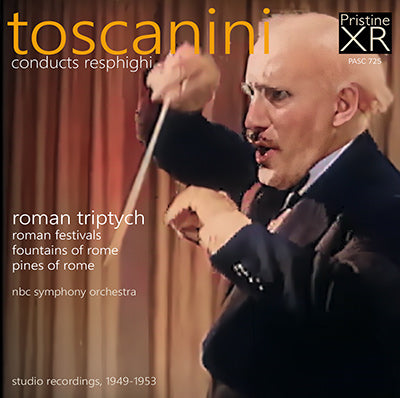
This album is included in the following sets:
This set contains the following albums:
- Producer's Note
- Full Track Listing
- Cover Art
The popularity, and even the existence of Ottorino Respighi’s Roman “triptych” (his description) of three tone poems, written between 1916 and 1928, owes a good deal to their association with Toscanini. The first of the tone poems to be written was Fountains of Rome (1916), preceding Pines of Rome (1924) and Roman Festivals (1928). Each movement depicts a setting at one of Rome's fountains at a different time of the day, specifically the Valle Giulia, Triton, Trevi, and Villa Medici. The premiere was held at the Teatro Augusteo on 11 March 1917, with Antonio Guarnieri conducting the Augusteo Orchestra. However, Respighi was disheartened at its initial mild reception and put away the score, until the piece was re-evaluated by the public following a February 1918 performance by conductor Arturo Toscanini which brought the composer international fame. Toscanini had originally planned to conduct the work in 1916, but the performance was abandoned following a dispute over German music having been programmed at a previous concert during the First World War.
Respighi completed Pines of Rome in the summer of 1924, after he had "conceived, started and restarted" work on the piece in the course of several years. Having relocated from his hometown of Bologna to Rome in 1913, Respighi said that the city's "marvellous fountains" and "umbrella-like pines that appear in every part of the horizon" were two characteristics that "[have] spoken to my imagination above all".
It has been observed that the piece is cyclical in nature in different ways; the Villa Borghese gardens, the Janiculum hill, and the Appian Way pinpoint a counter-clockwise tour around Rome's perimeter, and the four movements progress from day to night, ending with dawn. The setting of each movement goes back in time, from children playing in the contemporary city to the era of the catacombs from the early Christian period, before it concludes at the time of the Roman Republic. The piece also represents progressing through time, beginning with children playing and ending with grown men in uniform. Additionally the Janiculum hill is dedicated to Janus, the god of beginnings, endings and transitions, and has two faces, one of which looks forward and the other backward in time.
Although premiered in Italy in December 1924 under the baton of Bernadino Molinari, once again Toscanini had a hand in publicising the work: the American premiere took place on January 14 1926, during Toscanini's first concert as conductor of the New York Philharmonic. He also conducted the piece at his final performance with the orchestra in 1945. Respighi, who had arrived in the United States to embark on a concert tour in December 1925, conducted the work with the Philadelphia Orchestra a day after Toscanini's American premiere.
Roman Festivals, the final part of Respighi’s triptych, was completed in 1928. Each movement depicts a scene of celebration in ancient and contemporary Rome: gladiators battling to the death; the Christian Jubilee; a harvest and hunt festival; and a festival in the Piazza Navona. Musically, the piece is the longest and most demanding of Respighi's Roman trilogy. The premiere was held on 21 February 1929 at Carnegie Hall in New York City, with Arturo Toscanini conducting the New York Philharmonic.
Toscanini programmed tone poems from Respighi’s Roman triptych nine times in NBC broadcasts between 1939 and 1953. They were the only works by the composer which would feature in his radio concerts. The recordings presented here were each made for commercial release by RCA either just before or just after the orchestra had performed them for NBC broadcast – and each was very well rehearsed as a result.
The 1949 performance of Roman Festivals had pushed the very limits of the recording equipment of the day, as Toscanini insisted the engineers attempt to capture the full dynamics of the music, especially in "Circus Games" and "Epiphany". By the recording in 1953 of Pines of Rome that technology had already improved considerably and audibly. Nevertheless, in these Ambient Stereo XR remasters, all three recordings can now be heard in exceptional sound quality, minimising as much as possible any sonic differences between them.
Roman Festivals, P. 157 (1928)
1. Circuses (4:48)
2. The Jubilee (6:52)
3. The October Festival (7:20)
4. Epiphany (5:00)
Recorded 12 December 1949
Fountains Of Rome, P. 106 (1916)
5. The Fountain Of Valle Giulia At Dawn (3:50)
6. The Triton Fountain At Morning (2:44)
7. The Fountain Of Trevi At Midday (3:06)
8. The Villa Medici Fountain At Sunset (5:36)
Recorded 17 December 1951
Pines Of Rome, P. 141 (1924)
9. The Pines Of The Villa Borghese (2:35)
10. Pines Near A Catacomb (6:33)
11. The Pines Of The Janiculum (6:47)
12. The Pines Of The Appian Way (4:59)
Recorded 17 March 1953
NBC Symphony Orchestra
conducted by Arturo Toscanini
XR remastering by: Andrew Rose
Cover artwork based on a photograph of Toscanini
Recording venue: Carnegie Hall, New York City
Total duration: 60:10

